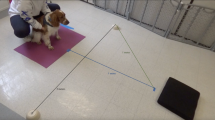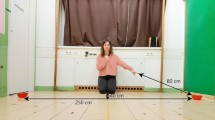Abstract
We review studies demonstrating the ability of some animals to understand the human pointing gesture. We present a 3-step analysis of the topic. (1) We compare and evaluate current experimental methods (2) We compare available experimental results on performance of different species and investigate the interaction of species differences and other independent variables (3) We evaluate how our present understanding of pointing comprehension answers questions about function, evolution and mechanisms. Recently, a number of different hypotheses have been put forward to account for the presence of this ability in some species and for the lack of such comprehension in others. In our view, there is no convincing evidence for the assumption that the competitive lifestyles of apes would inhibit the utilization of this human gesture. Similarly, domestication as a special evolutionary factor in the case of some species falls short in explaining high levels of pointing comprehension in some non-domestic species. We also disagree with the simplistic view of describing the phenomenon as a simple form of conditioning. We suggest that a more systematic comparative research is needed to understand the emerging communicative representational abilities in animals that provide the background for comprehending the human pointing gesture.







Similar content being viewed by others
References
Agnetta B, Hare B, Tomasello M (2000) Cues to food locations that domestic dogs (Canis familiaris) of different ages do and do not use. Anim Cogn 3:107–112
Allen C, Saidel E (1998) The evolution of reference. In Dellarosa DC, Allen C (eds) The evolution of mind. Oxford University Press, New York, pp 183–203
Anderson JR, Sallaberry P, Barbier H (1995) Use of experimenter-given cues during object-choice tasks by capuchin monkeys. Anim Behav 49:201–208
Anderson JR, Montant M, Schmitt D (1996) Rhesus monkeys fail to use gaze direction as an experimenter-given cue in an object-choice task. Behav Proc 37:47–55
Bates E, Benigni L, Bretherton I, Camaioni L, Volterra V (1977) From gesture to the first word: On cognitive and social prerequisites. In M Lewis, L Rosenblum (eds) Interaction, conversation, and the development of language. Wiley: New York
Bering JM (2004) A critical review of the “enculturation hypothesis”: The effects of human rearing on great ape social cognition. Anim Cogn 7:201–213
Blaschke M, Ettlinger G (1987) Pointing as an act of social communication by monkeys. Anim Behav 35:1520–1523
Boesch C, Boesch H (1989) Hunting behaviour of wild chimpanzees in the Tai Forest National Park. Am J Phys Anthr 78:547–573
Byrne RW (2003) Animal communication. What makes a dog able to understand its masters? Current Biology, 13:R347–R348
Call J (2001) Chimpanzee social cognition. Trends Cogn Sci 5:388–393
Call J, Tomasello M (1994) Production and comprehension of referential pointing by orangutans (Pongo pygmaeus). J Comp Psych 108:307–317
Call J, Tomasello M (1996) The effect of humans on the cognitive development of apes. In: Russon AE, Bard KA, Parker ST (eds), Reaching into thought: The minds of the great apes. Cambridge University Press, Cambridge, pp 371–403
Candland DK (1993) Feral children and clever animals. Oxford University Press, New York
Carpenter M, Tomasello M, Savage-Rumbaugh S (1995) Joint attention and imitative learning in children, chimpanzees and enculturated chimpanzees. Soc Devel 4:217–237
Chalmeau R, Gallo A (1993) Social constrains determine what is learned in the chimpanzee. Behav Proc 28:173–180
Connor RC, Norris KS (1982) Are dolphins reciprocal altruists? Am Nat 119:358–374
Evans CS (1997) Referential signals. In: Owings DH, Beecher MD, Thompson NS (eds.): Perspectives in Ethology, vol 12, Communication, Plenum Press, New York, pp 99–143
Gácsi M, Miklósi A, Varga O, Topál J, Csányi V (2004) Are readers of our face readers of our minds? Dogs (Canis familiaris) show situation-dependent recognition of human's attention. Anim Cogn 7:144–153
Gómez JC (1990) The emergence of intentional communication as a problem solving strategy in the gorilla. In: Parker TS, Gibson KR (eds), “Language” and intelligence in monkeys and apes: Comparative developmental perspectives. Cambridge University Press, Cambridge, pp 333–355
Gould SJ, Vbra ES (1982) Exaptation – a missing term in the science of form. Paleobiol 8:4–15
Hare B (2001) Can competitive paradigms increase the validity of experiments on primate social cognition? Anim Cogn 4:269–280
Hare B, Call J, Tomasello M (1998) Communication of food location between human and dog (Canis familiaris). Evol Commun 2:137–159
Hare B, Tomasello M (1999) Domestic dogs (Canis familiaris) use human and conspecific social cues to locate hidden food. J Comp Psychol 113:173–177
Hare B, Call J, Agnetta B, Tomasello M (2000) Chimpanzees know what conspecifics do and do not see. Anim Behav 59:771–785
Hare B, Brown M, Williamson C, Tomasello M (2002) The domestication of cognition in dogs. Science 298:1634–1636
Hauser M (1996) The evolution of communication. MIT Press, Cambridge Mass
Herman LM, Abichandani SL, Elhajj AN, Herman EYK, Sanchez JL, Pack AA (1999) Dolphins (Tursiops truncatus) comprehend the referential character of the human pointing gesture. J Comp Psychol 113:347–364
Itakura S, Tanaka M (1998) Use of experimenter given cues during object-choice tasks by chimpanzees (Pan troglodytes), an orangutan (Pongo pygmaeus), and human infants (Homo sapiens). J Comp Psychol 112:119–126
Itakura S, Agnetta B, Hare B, Tomasello M (1999) Chimpanzee use of human and conspecific social cues to locate hidden food. Devel Sci 2:448–456
Jenkins WO (1943) A spatial factor in chimpanzee learning. J Comp Psychol 35:81–84
Kaminski J, Riedel J, Call J, Tomasello M (2005) Domestic goats (Capra hircus) follow gaze direction and use some social cues in an object choice task. Anim Behav 69:11–18
Kumashiro M, Ishibashi H, Uchiyama Y, Itakura S, Murata A, Iriki A (2003) Natural imitation induced by joint attention in Japanese monkeys. Int J of Psychophysiol 50:81–99
Leavens AD, Hopkins WD (1999) The whole-hand point: The structure and function of pointing from a comparative perspective. J Comp Psychol 113:417–425
Le Boeuf BI, Crocker DE, Costa DP, Blackwell SB, Webb PM, Houser DS (2000) Foraging ecology of Northern elephant seals. Ecol Monogr 70:353–382
McConell BJ, Fedak MA, Lovell P, Hammond PS (1999) Movements and foraging areas of grey seals in the North-sea. J Appl Ecol 36:573–590
McKinley J, Sambrook TD (2000) Use of human given cues by domestic dogs (Canis familiaris) and horses (Equus caballus). Anim Cogn 3:13–22
Mech LD (1970) The wolf: The ecology and behaviour of an endangered species. Natural History Press, New York
Miklósi Á, Polgárdi R, Topál J, Csányi V (1998) Use of experimenter given cues in dogs. Anim Cogn 1:113–121
Miklósi Á, Polgárdi R, Topál J, Csányi V (2000) Intentional behaviour in dog-human communication: An experimental analysis of ‘showing’ behaviour in the dog. Anim Cogn 3:159–166
Miklósi A, Kubinyi E, Topál J, Gácsi M, Virányi Z, Csányi V (2003) A simple reason for a big difference: Wolves do not look back at humans but dogs do. Curr Biol 13:763–766
Miklósi Á, Pongrácz P, Lakatos G, Topál J, Csányi V (2005) A comparative study of dog-human and cat-human interactions in communicative contexts. J Comp Psych 119:179–186
Miles HLW (1990) The cognitive foundations for reference in a signing orangutan. In: Parker TS, Gibson KR (eds), “Language” and intelligence in monkeys and apes: Comparative developmental perspectives. Cambridge University Press, Cambridge, pp 511–539
Morissette P, Ricard M, Decarie TG (1995) Joint visual attention and pointing in infancy: A longitudinal study of comprehension. Br J Dev Psych 13:163–175
Nagell K, Olguin RS, Tomasello M (1993) Process of social learning in the tool use of chimpanzees (Pan troglodytes) and human children (Homo sapiens). J Comp Psychol 107:174–186
Neiworth JJ, Burman MA, Basile BM, Lickteig MT (2002) Use of experimenter-given cues in visual co-orienting and in an object-choice task by a new world monkey species, cotton top tamarins (Saguinus oedipus). J Comp Psychol 116:3–11
Owren MJ, Rendall D (1997) An affect-conditioning model of nonhuman primate vocalizations. In: Owings DW, Beecher MD, Thompson, NS (eds), Perspectives in Ethology, Vol. 12 Communication. Plenum Press. New York, pp. 299–346
Pack AA, Herman LM (2004) Bottlenosed dolphins (Tursiops trunctaus) comprehend the referent of both static and dynamic human gazing and pointing in an object-choice task. J Comp Psychol 118:160–171
Peignot P, Anderson JR (1999) Use of experimenter given manual and facial cues by gorillas (Gorilla gorilla) in an object-choice task. J Comp Psychol 113:253–260
Petit O, Desportes C, Thierry B (1992) Differential probability of co-production in two species of macaque (Macaca tonkeana, Mmulatta). Ethology 90:107–120
Pfungst O (1911) Clever Hans, the horse of Mr. von Osten. Henry Holt, New York
Povinelli DJ, Nelson KE, Boysen ST (1990) Inferences about guessing and knowing by chimpanzees (Pan troglodytes). J Comp Psychol 104:203–210
Povinelli DJ, Reaux JE, Bierschwale DT, Allain AD, Simon BB (1997) Exploitation of pointing as a referential gesture in young children, but not adolescent chimpanzees. Cogn Devel 12:423–461
Povinelli DJ, Bierschwale DT, Cech CG (1999) Comprehension of seeing as a referential act in young children, but not juvenile chimpanzees. Br J Devel Psychol 17:37–60
Povinelli DJ, Eddy TJ (1996) Chimpanzees: Joint visual attention. Psych Sci 7:129–135
Povinelli DJ, Giambrone S (1999) Inferring other minds: Failure of the argument by analogy. Philosophical Topics 27:167–201
Rosenthal R (1965) Clever Hans (the Horse of Mr Osten) by Oskar Pfungst. Henry Holt, New York
Savage-Rumbaugh SE (1986) Ape language: From conditioned response to symbol. Columbia University Press, New York
Scheumann M, Call J (2004) The use of experimenter given cues by South African fur seals (Arctocephalus pusillus). Anim Cogn 7:224–231
Shapiro AD, Janik VM, Slater PJB. (2003) Gray seal (Halichoerus grypus) pup responses to experimental-given pointing and directional cues. J Comp Psychol 117:355–362
Soproni K (2004) Gestural communication between dog and man. (Phd thesis, Eötvös University, Budapest, in Hungarian)
Soproni K, Miklósi Á, Topál J, Csányi V (2001) Comprehension of human communicative signs in pet dogs (Canis familiaris). J Comp Psychol 115:122–126
Soproni K, Miklósi Á, Topál J, Csányi V (2002) Dogs' (Canis familiaris) responsiveness to human pointing gestures. J Comp Psychol 116:27–34
Tinbergen N (1963) On and methods of ethology. Z Tierpsych 20:410–433
Tomasello M, Call J, Nagell K, Olguin R, Carpenter M (1994) The learning and use of gestural signals by young chimpanzees: A trans-generational study. Primates 35:137–154
Tomasello M, Call J, Hare B (1997a) Five primate species follow the visual gaze of conspecifics. Anim Behav. 55:1063–1069
Tomasello M, Call J, Gluckman A (1997b) Comprehension of novel communicative signs by apes and human children. Child Devel 68:1067–1080
Tomasello M, Camaioni L (1997) A comparison of the gestural communication of apes and human infants. Human Devel 40:7–24
Tomasello M, Call J (2004) The role of humans in the cognitive development of apes revisited. Anim Cogn 7:213–216
Trut LN (1999) Early canid domestication. The farm fox experiment. Am Scientist 87:160–169
Tschudin A, Call J, Dunbar RIM, Harris G, van der Elst C (2001) Comprehension of signs by dolphins (Tursiops truncatus). J Comp Psychol 115:100–105
Vea JJ, Sabater-Pi J (1998) Spontaneous pointing behaviour in the wild pygmy chimpanzees (Pan paniscus). Folia Prim 69:289–290
Vick S, Anderson JR (2000) Learning and limits of use of eye gaze by capuchin monkeys (Cebus apella) in an object-choice task. J Comp Psychol 114:200–207
Waal F de (1989) Food sharing and reciprocal obligations among chimpanzees. J Human Evol 18:433–459
Xitco MJ Jr, Roitblat HL (1996) Object recognition through eavesdropping: Passive echolocation in bottlenose dolphins. Anim Learn Behav 24:355–365
Xitco MJ, Gory JD, Kuczaj SA (2004) Dolphin pointing is linked to the attention behaviour of a receiver. Anim Cogn 7:231–238
Acknowledgements
This work has been supported by an OTKA grant (T043763) and grant of the Hungarian Academy of Sciences (F01/031). We are grateful to Josep Call and József Topál and two anonymous reviewers for providing valuable suggestions and constructive criticism on earlier versions of this paper
Author information
Authors and Affiliations
Corresponding author
Rights and permissions
About this article
Cite this article
Miklósi, Á., Soproni, K. A comparative analysis of animals' understanding of the human pointing gesture. Anim Cogn 9, 81–93 (2006). https://doi.org/10.1007/s10071-005-0008-1
Received:
Revised:
Accepted:
Published:
Issue Date:
DOI: https://doi.org/10.1007/s10071-005-0008-1




